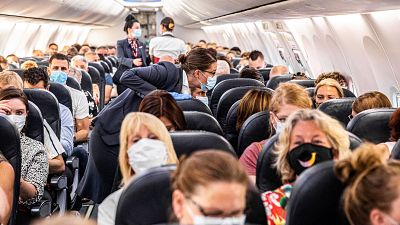Face masks to be scrapped on flights in Europe – this is when the law comes into force

The European Union will no longer require masks to be worn at airports and on planes starting next week, amid the easing of coronavirus restrictions across the bloc, authorities said on Wednesday.
The European Union Aviation Safety Agency said it hoped the joint decision, made with the European Centre for Disease Prevention and Control, would mark “a big step forward in the normalisation of air travel” for passengers and crews.
The new guideline “takes account of the latest developments in the pandemic, in particular the levels of vaccination and naturally acquired immunity, and the accompanying lifting of restrictions in a growing number of European countries,” the two agencies said in a joint statement.
When should I still wear a face mask on a plane?
“Passengers should however behave responsibly and respect the choices of others around them,” EASA Executive Director Patrick Ky said.
“And a passenger who is coughing and sneezing should strongly consider wearing a face mask, for the reassurance of those seated nearby.”
While the new recommendations take effect on 16 May, rules for masks may still vary by airline beyond that date if they fly to or from destinations where the rules are different.
European Centre for Disease Prevention and Control director Andrea Ammon said washing hands and social distancing should still be practised, but airport operators are advised not to impose distancing requirements if these are likely to lead to a bottleneck.
For example in the case where a new variant of concern emerged which was identified as potentially more dangerous.
Reaction to the new guidance
The International Air Transport Association (IATA) welcomed the new guidance.
“Travellers can look forward to freedom of choice on whether to wear a mask,” said Willie Walsh, IATA’s Director General.
“And they can travel with confidence knowing that many features of the aircraft cabin, such as high frequency air exchange and high efficiency filters, make it one of the safest indoor environments,” he added.
It was a similar sentiment from the Airports Council International (ACI).
“This new guidance marks another step in the safe recovery of European aviation and tourism, just as demand is fast increasing and prospects for the Summer look very positive,” Olivier Jankovec, Director General of ACI EUROPE said.
He continued: “It will make the travel experience much more pleasant and should also help to ease operations – while keeping passengers and staff safe”
However, national regulators and airlines will still have scope to demand face and nose covering by passengers and staff.
Germany’s Health Ministry said it will continue to require all passengers over the age of 6 to wear medical masks on flights to, from or within the country, though they can be removed during meals.
What will travel look like this summer?
The news is a boost to the European aviation sector which is still trying to return to pre-pandemic levels.
The number of countries that have removed all COVID-related entry restrictions is growing and many are also ditching domestic rules on masks and social distancing.
On Wednesday, the French government announced that masks will no longer be mandatory on public transport from 16 May.
Health minister Olivier Véran insisted that wearing a mask is still “recommended” in indoor spaces.
There have also been reports across Europe of delays at airports and mammoth queues as the sector struggles with returning demand.
